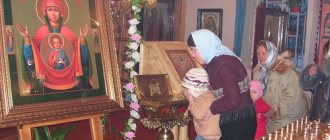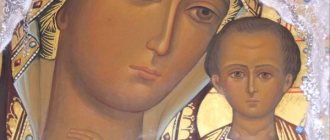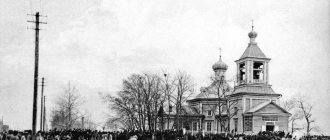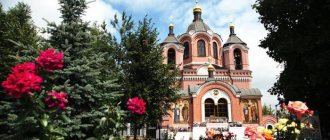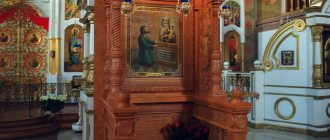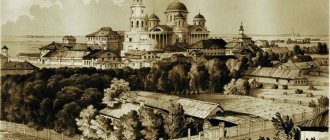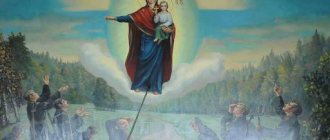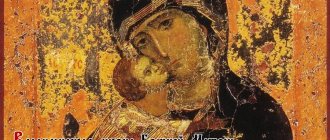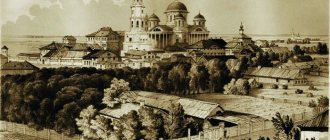| Novgorod Icon of the Mother of God “The Sign”. XII century, St. Sophia Cathedral, Veliky Novgorod. |
“The Sign,” icon of the Mother of God
Celebration November 27
The Znamenskaya Icon of the Mother of God depicts the Most Holy Theotokos sitting and raising Her hands in prayer; on her chest, against the background of a round shield (or sphere) is the blessing Divine Infant - Savior-Emmanuel.
This image of the Mother of God is one of Her very first iconographic images and inherits such ancient images as Oranta and Nikopeia. In Greece, such an image usually denoted the Nativity of Christ, and only in Russia such icons received the name “Sign,” i.e., a sign of the mercy of the Mother of God. Such icons of the Mother of God appeared in Rus' in the 12th century, and they began to be called so after a miraculous sign that occurred in 1170 from such an icon in Novgorod.
Novgorod Sign of the Blessed Virgin Mary
Description of the icon
The Novgorod Znamenskaya Icon is 13 1/2 inches high and 12 inches wide. Above the left eye of the Mother of God there was a mark from an arrow. On the sides of the icon there are images of the Great Martyr George the Victorious, the Martyr James the Persian and the Venerables Peter of Athos and Onuphrius the Great. The icon had a golden chasuble weighing over 71/2 pounds with precious stones.
Story
In the winter of 1170, the united forces of the Russian appanage princes, - according to the chronicler, “ not all of the Russian land united, there were only one princes then 72
“—led by Mstislav, the son of Vladimir-Suzdal Prince Andrei Bogolyubsky, they approached the walls of Veliky Novgorod. Even before approaching the city, they began to rob and burn villages, beat men, and take children and women captive to make them their slaves. Negotiations in front of the city walls were unsuccessful and a battle began.
In Novgorod, churches were not closed day or night, and church singing mixed with the crying of the people.
Archbishop Saint Elijah, since the enemies approached Novgorod, prayed tirelessly for three days and three nights in the Cathedral of St. Sophia for the salvation of the city. On the third night, standing in front of the icon of the All-Merciful Savior, he suddenly felt a sacred awe, and then a voice was heard from the icon: Go to the Church of Our Lord Jesus Christ, which is on Ilyinskaya Street, take the image of the Most Holy Theotokos there, lift it up to the city walls, and then you will see the salvation of the city
.
A wonderful calm then poured into the weary heart of the saint. In fervent, tender prayer, without words, he fell prostrate before the icon and spent the whole night in prayer. In the morning, he gathered the clergy and townspeople and told them about the mysterious voice, awakening hope in them. The archbishop sent the protodeacon and clergy to the Church of the Savior on Ilyinskaya Street to bring from there an icon of the Mother of God, and he himself began to sing a prayer service at the cathedral. But despite all the efforts of those sent, they could not move the icon from its place, and with this news they returned to the archbishop. Then the saint himself, at the head of the procession, accompanied by the people and clergy, went to the Church of the Savior. There he fell on his knees in front of the icon of the Mother of God and turned to the Most Holy One with a tearful prayer. They began to serve a prayer service, and when they sang: “ The intercession of Christians is not shameful, the intercession to the Creator is immutable, do not despise the voices of sinful prayers.”
", the icon itself hesitated, as if moving towards the archbishop.
Seeing this miracle, the people and clergy joyfully cried out: “ Lord, have mercy!”
"
The archbishop took the miraculous image in his arms, venerated it, and then the icon was carried in triumph to the city wall and placed facing the attackers. But Mstislav’s warriors did not relent and fired whole clouds of arrows at the Novgorodians, one of which pierced the iconographic face of the Mother of God. Tears flowed from Her eyes, and the icon itself turned its face to the city. At the same time, terror fell on the attackers. Their vision became darkened and they began to strike each other. The Novgorodians, encouraged by the sign, rushed at their enemies, defeated them completely and took many into captivity. Those who fled could not find food for themselves where they had previously wrought merciless devastation. They died from hunger and disease, and as the chronicler says with horror, during Lent they ate the meat of their horses.
Celebration and new miracles from the Novgorod image
Archbishop Elijah then established a celebration in memory of the miraculous intercession provided by the Mother of God to Novgorod. Since February 25, the day on which this event took place, almost always falls on Maslenitsa or Lent, the holiday is moved to November 27. The image of the Znamensky image began to be placed on the seals of the Novgorod ruler.
The Athonite hieromonk Pachomius Logothetes, who was present at the celebration of the icon in Russia, wrote two canons for this holiday. Some Novgorod Znamensky icons depict the miraculous event of 1170 in three acts: at the top - the transfer of the icon from the Church of the Savior to the city wall; below are negotiations between both sides, and below is the battle itself, where the Novgorodians are helped by angels with long lances.
In 1352, through prayer in front of this icon, those affected by the plague were healed.
For almost two centuries, the miraculous icon of the “Sign” of the Mother of God stood on Ilyinskaya Street, in the wooden Church of the Savior. In 1356, a fire that broke out in the church subsided after a prayer service in front of this icon. In 1357, it was moved to the newly built stone church in honor of the Sign on the same Ilyinskaya Street, which became the cathedral of the Znamensky Monastery.
In 1565, the icon was restored by Metropolitan Macarius [1]. The following year, a strong fire broke out in Novgorod, engulfing many streets. No amount of effort could stop the formidable element. Then Metropolitan Macarius went with a procession to the Church of the Sign and there, kneeling before the miraculous icon, he prayed for an end to the disaster. Then, picking up the icon, he carried it in a religious procession along the banks of the Volkhov. Soon the wind blew towards the river, and the fire began to subside.
In 1611, the Swedes captured Novgorod. Beating the Novgorodians, they plundered houses and churches, desecrated icons, and carried away sacred dishes and utensils. One day, several Swedes approached the Church of the Sign, where a service was being held at that time, and the doors were therefore open. They rushed into the church to rob it, but an invisible force threw them back. They rushed to the doors again and were again driven back. This became known to all the Swedes, and none of them tried to enter this temple again.
In 1636, silversmith Luka Plavilshchikov planned to rob this church. At the end of the evening service on November 27, he hid in the church, and at night he entered the altar, collected silver vessels from the altar, poured money out of the mugs and, finally, began to approach the miraculous icon to tear off the precious decorations from it. But as soon as he touched the robe, he was thrown away from the icon and fell unconscious on the floor. Before Matins, the sexton who came to the church took him out, believing that Luke remained in the church drunk. He did not notice that Plavilshchikov had church vessels with him. The theft was discovered when they began to serve Matins, and everything was found in Luke’s house. The thief lost his mind for a while and only later spoke about the miracle that happened from the icon.
Subsequently, the miraculous icon of the “Sign” of the Mother of God stood in the iconostasis of the Cathedral of the Sign, to the left of the royal doors.
After the October Revolution of 1917, the icon entered the museum collection of the Novgorod Museum. During the Great Patriotic War it was evacuated and at the end of the war it was returned to the museum-reserve.
On August 15, 1991, the icon was returned to the Novgorod diocese. On this day, many of those present witnessed a celestial phenomenon: a rainbow surrounded the golden dome of the Novgorod St. Sophia Cathedral, and then began to rise and dissolved in the cloudless sky. The icon resides in the St. Sophia Cathedral of Veliky Novgorod.
Spiritual meaning of the icon
The Sign initially means the fulfillment of Old Testament prophecies about the imminent coming of the Savior to the world, since the Mother of God herself is the herald of the coming Messiah.
In addition, the Blessed Virgin reveals the Sign during civil strife, so that fellow believers will repent of fratricide and stop the strife. This is the paradox of such conflicts - believers in one God inevitably called on Him for help when going to war. And if those who defend themselves are heard by God, then the attackers have no excuse for their blasphemous prayers.
The Mother of God is depicted on the icon of the Sign in prayer, with her hands outstretched upward. Theologians pay attention to the canonicity of this gesture. Moses also raised his hands to heaven during the battle between the Israelites and the Amalekites, and when he weakened, Aaron and Hur supported him. The priest at the liturgy also prays with his hands outstretched to God, proclaiming “woe is our heart.”
Prayers
Troparion, tone 4
Like an insurmountable wall and a source of miracles, / having acquired Thee, Thy servants, Most Pure Mother of God, / we overthrow the resistant militias. / We also pray to Thee, / grant peace to our fatherland // and great mercy to our souls
.
Kontakion, tone 4
Come, faithful ones, let us brightly celebrate / the miraculous appearance of the all-honorable image of the Mother of God / and from this we draw grace, / let us cry out most tenderly: // Rejoice, Mary Theotokos, Mother of God, Blessed One
.
Prayer
O Most Holy and Most Blessed Mother of our Sweetest Lord Jesus Christ! We fall down and worship You before Your holy, miraculous icon, remembering the wondrous sign of Your intercession, which was revealed to the great Novegrad during the days of the military invasion of this city. We humbly pray to You, O All-Powerful Intercessor of our family: just as in ancient times You hastened to help our fathers, so now we, weak and sinners, have been made worthy of Your maternal intercession and care. Save and preserve, O Lady, under the cover of Your mercy, the Holy Church, Your city (Your abode), our entire Orthodox country and all of us who fall to You with faith and love, tenderly asking with tears for Your intercession. Hey, Madam All-Merciful! Have mercy on us, overwhelmed by many sins, stretch out Thy God-receiving hand to Christ the Lord and intercede for us before His goodness, asking us forgiveness of our sins, a pious peaceful life, a good Christian death and a good answer at His terrible Judgment, yes, we are saved by Thy almighty to Through His prayers, we will inherit the bliss of heaven and with all the saints we will sing the Most Honorable and Magnificent Name of the Most Worshipful Trinity, Father and Son and Holy Spirit, and Your great mercy to us forever and ever. Amen
.
Writing a list
In 1944, the icon of the Mother of God ended up in Munich, where the Synod of the Orthodox Church Abroad moved. Before transferring the miraculous face of the Mother of God to America in order to save it from destruction, it was decided to make a list.
The work was entrusted to Hieromonk Cyprian, who reverently opened the shrine and was dumbfounded, for in front of him lay a board black with soot with barely visible drawings. The icon painter did not know what to do correctly, because he had not received a blessing for the restoration, and there was nothing to paint.
At his own peril and risk, without the permission of the Metropolitan, Cyprian began to wash the icon stroke by stroke, and the Mother of God and Child shone before him under the cover of the Lord, surrounded by Old Testament prophets.
Kursk-Root Icon of the Mother of God “The Sign”
Without waiting for the morning, Cyprian woke up Archimandrite Seraphim, who was amazed by what he saw, but did not know how to confess to the bishop that a miracle had happened through disobedience. The arriving bishop saw the will of God in disobedience, served a prayer service near the icon and blessed Father Cyprian to write the copy.
After both images were dressed in vestments, a piece of wood was split off from the original and mounted on the list. The original flew to America, but the list remained in Europe.
In 1950, the Kursk-Root Hermitage was built near New York, and the miraculous icon of the Mother of God moved into it. In 1957, the Kursk-Root Icon became the guardian of the Cathedral of the Sign, built in honor of this holy image.
The Kursk shrine arrives in Russia in 2000 for the period of worship, and then returns to America again.
On a note! Christians of the North American and Canadian diocese have the opportunity to venerate the Kursk-Root icon every year even today.
In the year of celebrating the millennium of the Baptism of Rus', she visited Australian churches and parishes in South America.
The miraculous shrine fills the hearts of Christians with joy, consolation and hope for help from the Most Pure Mother of God. For the Western world, Russian Orthodox Christians scattered across all corners of the earth, Oranta became a symbol of unity. Now the keeper of the Kursk Icon of the Mother of God “The Sign” is Bishop Nikolai Olkhovsky.
Used materials
- Website page Orthodox names
: - Villager. E., Our Lady.
Description of Her earthly life and miraculous icons , Moscow: ANO “Orthodox Journal “Christian's Rest””, 2002, “Tales of the miraculous icons of the Mother of God”: - - November
, December 10, 2009:
, November 29, 2008:
[1] Possible error, because By this time, Saint Macarius of Moscow had died.
Honored dates
On March 21, Orthodox Christians thank God and the Mother of God for saving the holy image during a terrorist attack, when a bomb was planted and exploded under it.
On the ninth Friday after the Resurrection of the Lord, thousands of parishioners take part in a religious procession from the Znamenskaya Monastery to the Root Hermitage. On the Feast of the Nativity of the Blessed Virgin Mary, September 21, the day of the discovery of the holy image on the river bank is celebrated.
On December 10, Orthodox Christians around the world pay tribute to the icon of the Mother of God “The Sign”.
When do they call on the image and how does the icon of the Mother of God “The Sign” help?
In front of such an icon, you can offer a variety of prayers - from praise and thanksgiving to supplication. It is believed that it gives Christians protection in conflicts, both family and interstate, relieves anger, prevents rashness in judgment, pacifies negative emotions, and softens the hearts of enemies. In addition, small lists of images are traditionally given to travelers - they allow you to easily and quickly resolve any unwanted situations that arise away from home, find friendly travel companions, and return home safe and sound.
In addition, when listing how the icon of the Mother of God “The Sign” helps, we must not forget that it cures various ailments, especially having a beneficial effect on eye diseases - myopia, cataracts, astigmatism, etc. Cities suffering from epidemics were also surrounded by the shrine - and the spread of the disease stopped. And the image also protects the home from the invasion of thieves, envious people and ill-wishers, evil gossip, gossip, and quarrels. He seems to overshadow his household with his grace, instilling love and peace in their hearts, strengthening them in faith, saving them from thoughtless actions, bestowing patience, meekness and humility.
That is why such amber icons will be a welcome gift for every Christian. And our online store “Yantar Polesie” will help you purchase them. All products presented in the catalog are certified - which means they are of the highest quality, durability, uniqueness and exactly comply with the canons.
Questions for the priest
Christians venerate the Mother of God and are interested in which icons in the Oranta style are older than the Novgorod “Sign”.
While dismantling the catacombs of Callistus in Rome, a fragment of a painting with the Virgin Mary was found on the vault. She is depicted praying, with outstretched arms, but without the baby. The image dates back to the second half of the 3rd century.
In Palestine in the 6th and 7th centuries, the praying Mother of God was depicted on the ampoule of Monza. The surface of the vessel was covered with several drawings, limited to circles.
In Serbia, a fresco painted in the 14th century has survived to this day. On it, the Mother of God in a tunic is drawn in full growth. On her chest is Emmanuel in a circle.
